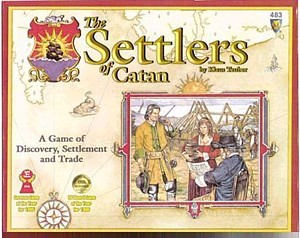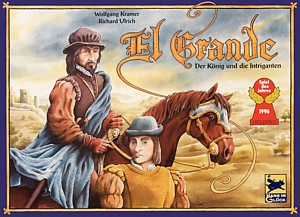Permit me to assume that the modern age of board games known as Euro board games begins in 1995. It may have started a little sooner than that, but taking into consideration that The Settlers of Catan was published then, it will serve our purposes here rather nicely. Below you can find descriptions of some of the more popular board games from 1995.

There is an ever-changing listing of highly-regarded fun board games at BoardGameGeek.com that, as of this writing, shows The Settlers of Catan as the 46th most popular game (as voted for by members of that site) out of over 46,000 games in their database. Re-ordering the top 100 games from that listing by the year in which they were published and pulling out only those from the late 1990s, results in the following ten fun board games shown in the table below.
The Settlers of Catan, is one of the big three Gateway Games. Along with Carcassonne and Ticket to Ride, these three are often used to introduce newcomers to the art and fun of the Eurogame. Tigris & Euphrates, is among the current top 10 (from that master list of 100) most popular fun board games.
Links take you to Amazon.
| The Settlers of Catan | 1995 |
| El Grande Decennial Edition | 1995 |
| Hannibal: Rome vs Carthage | 1996 |
| Tigris & Euphrates | 1997 |
| Samurai | 1998 |
| Ra | 1999 |
| Tikal | 1999 |
| Roads & Boats | 1999 |
| Union Pacific | 1999 |
| Paths of Glory | 1999 |
Let’s take a brief look at the first two fun board games in this list. While not every game in this list is a Euro board game, these both are. I’ll try to describe a little bit about why people who enjoy these fun board games think that they are just that – fun board games.
The Settlers of Catan
The Settlers of Catan is often considered the Euro board game that started it all in the realm of Euro, or German, board games because it has become so widely-played and well-liked. On the fictional island of Catan, which is a modular board made of various types of large, hexagonal-shaped tiles, players compete to build roads, settlements, and cities (normally made of wooden bits) in their own color by collecting resources (cards) such as wood, brick, ore, grain, and sheep. These are used in various preset combinations to construct (that is, trade-in for) the roads, settlements, and cities.
Dice are used in this fun board game but not as part of the traditional roll-and-move mechanism in other fun board games like Monopoly or Clue. The roll of the dice instead determines which resources, if any, a player will collect on a given turn. The first player to amass ten points by building the most settlements and cities, developing the largest army (more cards), paving the longest road, and collecting the most victory point development cards is declared the winner. A key factor in attaining a win in this board game, is trading resource cards with fellow players. Use this tactic skillfully, and you are likely to beat them to the goal.
El Grande

This fun board game is my personal favorite. El Grande was published in the same year, 1995, as The Settlers of Catan. Even though El Grande currently ranks higher on the popularity scale at Board Game Geek, it probably doesn’t have the broad appeal of The Settlers of Catan because, generally speaking, it requires a bit more thought and analysis each turn. There is also a little less interaction because there is no trading of cards going on. However, that doesn’t make this fun board game any less fun.
El Grande is often considered the best area-control Euro board game available. In an area-control board game, players try to maintain a majority of their pieces in each of several areas of the game board. Officially in El Grande, these pieces – though they are but small, painted, wooden cubes – are known as caballeros. When I play this fun board game, I prefer simply to call them “dudes.”
In each of the nine rounds that comprise a full game, each player “bids” for the number of dudes he gets to play onto one or more of the eight areas of the game board. Bidding is not done using the traditional auction method but rather through the playing of one of 13 power cards that each player holds in his hand. The power card determines who gets to play first that round and how many dudes he has available for placement.
Placement on the game board is further complicated by the five action cards available each round. Each player must pick one of the cards, which have a multitude of effects on gameplay, before placing his dudes onto one or more of the eight provinces (The board is a map of early Spain.) or in a special tower called the Castillo.
Each of the provinces has a different set of scoring values. Whoever controls a given province by having the most dudes there when scoring occurs, gets the most points. Whoever has the second-highest number of dudes scores a few points less. The same generally goes for the third-highest. However, when there are four or five players, everyone after third-highest scores nothing. After rounds three, six, and nine, general scoring occurs. Whoever has accumulated the most points after that final scoring round is the winner of this fun board game.

Pingback:Popular Fun Board Games from 1997 and 1998 | Fun Board Games